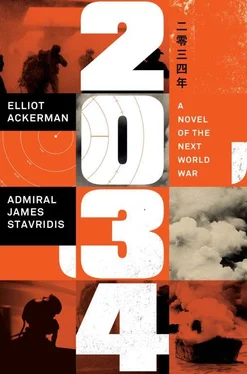The chief petty officer who was leading the party explained that they’d searched most of the trawler but that a steel, watertight hatch secured one of the stern compartments and the crew had refused to unlock it. The chief had ordered a welding torch brought from the ship’s locker. In about fifteen minutes they’d have everything opened up.
The clean-shaven man, the trawler’s captain, began to speak in uncertain and heavily accented English: “Are you command here?”
“You speak English?” Hunt replied.
“Are you command here?” he repeated to her, as if perhaps he weren’t certain what these words meant and had simply memorized them long ago as a contingency.
“I am Captain Sarah Hunt, United States Navy,” she answered, placing her palm on her chest. “Yes, this is my command.”
He nodded, and as he did his shoulders collapsed, as if shrugging off a heavy pack. “I surrender my command to you.” Then he turned his back to Hunt, a gesture that, at first, seemed to be a sign of disrespect, but that she soon recognized as being something altogether different. In his open palm, which was cuffed behind him at the wrist, was a key. He’d been holding it all this time and was now, with whatever ceremony he could muster, surrendering it to Hunt.
Hunt plucked the key from his palm, which was noticeably soft, not the calloused palm of a fisherman. She approached the compartment at the stern on the Wén Rui , popped off the lock, and opened the hatch.
“What we got, ma’am?” asked the master-at-arms, who stood close behind her.
“Christ,” said Hunt, staring at racks of blinking miniature hard drives and plasma screens. “I have no idea.”

13:47 March 12, 2034 (GMT+4:30)
Strait of Hormuz
When Wedge switched to manual control, the Lockheed contractors on the George H. W. Bush immediately began to radio, wanting to know if everything was okay. He hadn’t answered, at least not at first. They could still track him and see that he was adhering to their flight plan, which at this moment placed him approximately fifty nautical miles west of Bandar Abbas, the main regional Iranian naval base. The accuracy of his flight proved—at least to him—that his navigation was as precise as any computer.
Then his F-35 hit a pocket of atmospheric turbulence—a bad one. Wedge could feel it shudder up the controls, through his feet, which were planted on the rudder pedals, into the stick, and across his shoulders. The turbulence threatened to throw him off course, which could have diverted him into the more technologically advanced layers of Iranian air defenses, the ones that expanded outward from Tehran, in which the F-35’s stealth countermeasures might prove inadequate.
This is it , he thought.
Or at least as close to it as he had ever come. His manipulation of throttle, stick, and rudder was fast, instinctual, the result of his entire career in the cockpit, and of four generations’ worth of Mitchell family breeding.
He skittered his aircraft on the edge of the turbulence, flying for a total of 3.6 nautical miles at a speed of 736 knots with his aircraft oriented with 28 degrees of yaw respective to its direction of flight. The entire episode lasted under four seconds, but it was a moment of hidden grace, one that only he and perhaps his great-grandfather watching from the afterlife appreciated in the instant of its occurrence.
Then, as quickly as the turbulence sprung up, it dissipated, and Wedge was flying steadily. Once again, the Lockheed contractors on the George H. W. Bush radioed, asking why he’d disabled his navigation computer. They insisted that he turn it back on. “Roger,” said Wedge, as he finally came up over the encrypted communications link, “activating navigation override.” He leaned forward, pressed a single innocuous button, and felt a slight lurch, like a train being switched back onto a set of tracks, as his F-35 returned to autopilot.
Wedge was overcome by an urge to smoke a cigarette in the cockpit, just as Pappy Boyington used to do, but he’d pushed his luck far enough for today. Returning to the Bush in a cockpit that reeked of a celebratory Marlboro would likely be more than the Lockheed contractors, or his superiors, could countenance. The pack was in the left breast pocket of his flight suit, but he’d wait and have one on the fantail after his debrief. Checking his watch, he calculated that he’d be back in time for dinner in the pilots’ dirty shirt wardroom in the forward part of the carrier. He hoped they’d have the “heart attack” sliders he loved—triple cheeseburger patties with a fried egg on top.
It was while he was thinking of that dinner—and the cigarette—that his F-35 diverted off course, heading north, inland toward Iran. This shift in direction was so smooth that Wedge didn’t even notice it until another series of calls came from the Bush , all of them alarmed as to this change in heading.
“Turn on your navigation computer.”
Wedge tapped at its screen. “My navigation computer is on…. Wait, I’m going to reboot.” Before Wedge could begin the long reboot sequence, he realized that his computer was nonresponsive. “Avionics are out. I’m switching to manual override.”
He pulled at his stick.
He stamped on his rudder pedals.
The throttle no longer controlled the engine.
His F-35 was beginning to lose altitude, descending gradually. In sheer frustration, a frustration that bordered on rage, he tugged at the controls, strangling them, as if he were trying to murder the plane in which he flew. He could hear the chatter in his helmet, the impotent commands from the George H. W. Bush , which weren’t even really commands but rather pleadings, desperate requests for Wedge to figure out this problem.
But he couldn’t.
Wedge didn’t know who or what was flying his plane.

07:23 March 12, 2034 (GMT-4)
Washington, D.C.
Sandy Chowdhury had finished his energy bar, was well into his second cup of coffee, and the updates would not stop coming. The first was this news that the John Paul Jones had found some type of advanced technological suite on the fishing trawler they’d boarded and lashed to their side. The commodore, this Sarah Hunt, whose judgment Hendrickson so trusted, was insistent that within an hour she could offload the computers onto one of the three ships in her flotilla for further forensic exploitation. While Chowdhury was weighing that option with Hendrickson, the second update came in, from Seventh Fleet Headquarters, “INFO” Indo-Pacific Command. A contingent of People’s Liberation Army warships, at least six, to include the nuclear-powered carrier Zheng He , had altered course, and were heading directly toward the John Paul Jones.
The third update was most puzzling of all. The controls of the F-35, the one whose flight had brought Chowdhury into the Situation Room early that snowy Monday morning, had locked up. The pilot was working through every contingency, but at this moment, he was no longer in control of his aircraft.
“If the pilot isn’t flying it, and we’re not doing it remotely from the carrier, then who the hell is?” Chowdhury snapped at Hendrickson.
A junior White House staffer interrupted them. “Dr. Chowdhury,” she said, “the Chinese defense attaché would like to speak with you.”
Chowdhury shot Hendrickson an incredulous glance, as if he were willing the one-star admiral to explain that this entire situation was part of a single, elaborate, and twisted practical joke. But no such assurance came. “All right, transfer him through,” said Chowdhury as he reached for the phone.
Читать дальше













